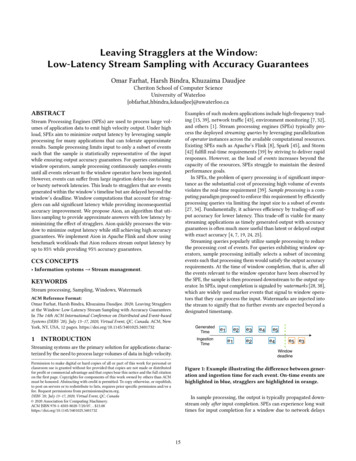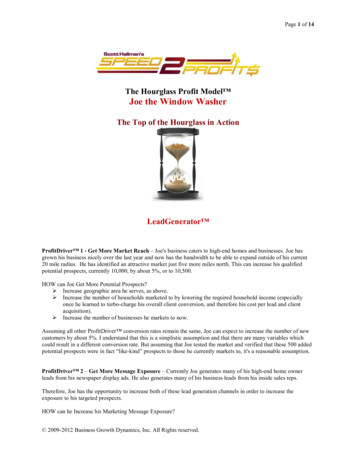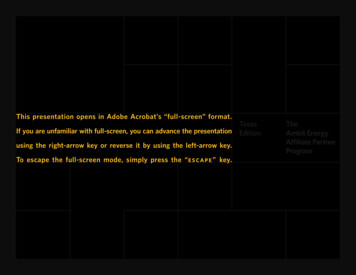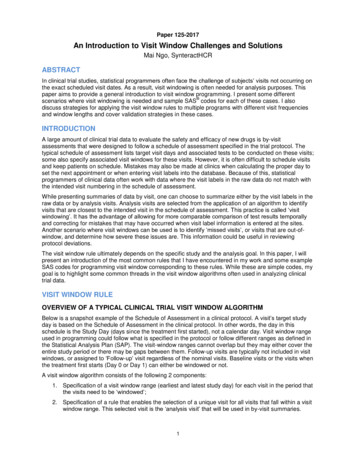
Transcription
Leaving Stragglers at the Window:Low-Latency Stream Sampling with Accuracy GuaranteesOmar Farhat, Harsh Bindra, Khuzaima DaudjeeCheriton School of Computer ScienceUniversity of STRACTExamples of such modern applications include high-frequency trading [15, 39], network traffic [43], environment monitoring [7, 32],and others [1]. Stream processing engines (SPEs) typically process the deployed streaming queries by leveraging parallelizationof operator instances across the available computational resources.Existing SPEs such as Apache’s Flink [8], Spark [45], and Storm[42] fulfill real-time requirements [39] by striving to deliver rapidresponses. However, as the load of events increases beyond thecapacity of the resources, SPEs struggle to maintain the desiredperformance goals.In SPEs, the problem of query processing is of significant importance as the substantial cost of processing high volume of eventsviolates the real-time requirement [39]. Sample processing is a computing paradigm proposed to enforce this requirement by efficientlyprocessing queries via limiting the input size to a subset of events[27, 34]. Fundamentally, it achieves efficiency by trading-off output accuracy for lower latency. This trade-off is viable for manystreaming applications as timely generated output with accuracyguarantees is often much more useful than latent or delayed outputwith exact accuracy [4, 7, 19, 24, 25].Streaming queries popularly utilize sample processing to reducethe processing cost of events. For queries exhibiting window operators, sample processing initially selects a subset of incomingevents such that processing them would satisfy the output accuracyrequirements. At the time of window completion, that is, after allthe events relevant to the window operator have been observed bythe SPE, the sample is then processed downstream to the output operator. In SPEs, input completion is signaled by watermarks [28, 38],which are widely used marker events that signal to window operators that they can process the input. Watermarks are injected intothe stream to signify that no further events are expected beyond adesignated timestamp.Stream Processing Engines (SPEs) are used to process large volumes of application data to emit high velocity output. Under highload, SPEs aim to minimize output latency by leveraging sampleprocessing for many applications that can tolerate approximateresults. Sample processing limits input to only a subset of eventssuch that the sample is statistically representative of the inputwhile ensuring output accuracy guarantees. For queries containingwindow operators, sample processing continuously samples eventsuntil all events relevant to the window operator have been ingested.However, events can suffer from large ingestion delays due to longor bursty network latencies. This leads to stragglers that are eventsgenerated within the window’s timeline but are delayed beyond thewindow’s deadline. Window computations that account for stragglers can add significant latency while providing inconsequentialaccuracy improvement. We propose Aion, an algorithm that utilizes sampling to provide approximate answers with low latency byminimizing the effect of stragglers. Aion quickly processes the window to minimize output latency while still achieving high accuracyguarantees. We implement Aion in Apache Flink and show usingbenchmark workloads that Aion reduces stream output latency byup to 85% while providing 95% accuracy guarantees.CCS CONCEPTS Information systems Stream management.KEYWORDSStream processing, Sampling, Windows, WatermarkACM Reference Format:Omar Farhat, Harsh Bindra, Khuzaima Daudjee. 2020. Leaving Stragglersat the Window: Low-Latency Stream Sampling with Accuracy Guarantees.In The 14th ACM International Conference on Distributed and Event-basedSystems (DEBS ’20), July 13–17, 2020, Virtual Event, QC, Canada. ACM, NewYork, NY, USA, 12 pages. imeINTRODUCTIONIngestionTimeStreaming systems are the primary solution for applications characterized by the need to process large volumes of data in high-velocity.e1e2e1e3e2e4e5e4e5 e3WindowdeadlinePermission to make digital or hard copies of all or part of this work for personal orclassroom use is granted without fee provided that copies are not made or distributedfor profit or commercial advantage and that copies bear this notice and the full citationon the first page. Copyrights for components of this work owned by others than ACMmust be honored. Abstracting with credit is permitted. To copy otherwise, or republish,to post on servers or to redistribute to lists, requires prior specific permission and/or afee. Request permissions from permissions@acm.org.DEBS ’20, July 13–17, 2020, Virtual Event, QC, Canada 2020 Association for Computing Machinery.ACM ISBN 978-1-4503-8028-7/20/07. . . 15.00https://doi.org/10.1145/3401025.3401732Figure 1: Example illustrating the difference between generation and ingestion time for each event. On-time events arehighlighted in blue, stragglers are highlighted in orange.In sample processing, the output is typically propagated downstream only after input completion. SPEs can experience long waittimes for input completion for a window due to network delays15
DEBS ’20, July 13–17, 2020, Virtual Event, QC, CanadaOmar Farhat, Harsh Bindra, Khuzaima Daudjee[33, 36]. For instance, in the example illustrated in Fig.1, the SPEwaits for the arrival of events 𝑒 3 and 𝑒 5 even after the window’sdeadline. Consequently, stragglers delay input completion therebyincreasing output latency. Consider Fig. 2 that illustrates the impact of stragglers on output latency for a time-window of size 1.5swhere the network delay of events varies based on distributionsthat are modeled from real-world traces [36]. For a network delaythat is Gamma distributed (light-tail), stragglers impose a significant 25% additional wait-time to guarantee input completion. Asfor Exponentially distributed delays (heavy tail), the imposed latency is exacerbated by more than 99%, effectively delaying theinput completion way beyond the window’s deadline. The impactof stragglers on output latency is significantly high so as to overshadow the acquired benefits from sample processing. To the best ofour knowledge, none of the existing sample processing techniquesmitigate the impact of stragglers on the output latency [14, 17, 25].can propagate their output downstream as soon as output accuracyrequirements are satisfied thereby circumventing the costly slackdelay, and, consequently, reducing the output latency significantly.Figure 3: Relative accuracy of sample processing window operators with and without stragglers.To illustrate the impact of stragglers on output results, consider Fig. 3 that shows output accuracy results obtained running a sample processing algorithm in two settings: with andwithout stragglers. The first setting takes stragglers into account thereby waiting for input completion while the secondcircumvents stragglers by processing the window’s input assoon the deadline is due and the accuracy requirements aresatisfied. In both settings, the algorithm ran with a target output accuracy of 95% over two popular streaming benchmarksthat include windowed operators of different functionalities.The first popular benchmark is the Yahoo! Streaming Benchmark (YSB) [20] and the second is the New York Taxi (NYT)benchmark [32]. The figure shows that sampling with stragglers provides an insignificant improvement of less than 1%compared to sampling without stragglers for both YSB andNYT benchmarks. We also ran the kMeans benchmark as anexample of a query with a windowed operator of higher complexity. The accuracy difference between the two samples wasonly about 1% indicating that the two samples shared identical statistical significance. These results demonstrate thatnot only do stragglers impose large output latency on inputcompletion, they contribute insignificantly towards achievinghigher output accuracy.Figure 2: Input completion rate for window operators withnetwork delay for events modeled by empirically verifieddistributions.Mitigating the problem of stragglers on sample processing whilestriking a balance between accuracy and latency is a challengingproblem to solve. This is because:(i) Straggler count and delay patterns vary based on an application’s environment. To choose a sample that satisfies thespecified accuracy guarantees requires constructing reliableestimations of the straggler events. However, network delays,and in particular the case of exponential delay distributions,adds high variability to any estimation technique.(ii) Choosing a sample that satisfies the accuracy guarantees isnot a trivial task. The sampled events need to be statisticallyrepresentative of the original input that includes the stragglers.Furthermore, the size of the sample needs to be intelligentlychosen based on the functionality of the window operator.(iii) Determining the minimum number of stragglers to includein the sample can have a large impact on the output latency.As illustrated in Fig. 2, stragglers impose a significant delaypenalty on the output latency. Hence, the number of includedstragglers needs to be minimized.In this paper, we demonstrate that sample processing does notneed to wait for input completion to process its sampled input. Morespecifically, existing sample processing approaches do not need toadd a slack delay to account for stragglers [24]. Instead, windowsThis observation motivates the work in this paper in which wepresent the design and implementation of our sample processingalgorithm called Aion. Aion continuously monitors and samplesimportant patterns in the workload such as network and inter-eventgeneration delays to estimate the pattern of events and stragglers.Aion then utilizes these estimations, in addition to the type ofthe window operator, to compute the minimum sample size thatachieves the accuracy guarantees. Aion also exploits straggler patterns by intelligently processing the sample before input completionsuch that the impact of stragglers is mitigated. As we demonstratein our experiments, Aion delivers significant performance gains toreduce latency by as much as 80%.This paper is organized as follows: We describe backgroundmaterial in Sec. 2 and Aion’s design and its algorithmic details in16
Leaving Stragglers at the Window:Low-Latency Stream Sampling with Accuracy GuaranteesDEBS ’20, July 13–17, 2020, Virtual Event, QC, CanadatsSec. 3. We present our experiments in Sec. 4, discuss relevant workin Sec. 5, and conclude in Sec. 6.24BACKGROUNDstragglerThis section discusses windows, watermarks, and sample processingto provide relevant background on the problem, after which wepresent our design of Aion.2.16materializewindow [3, 6]event52ts5eventdropped34watermark31Window6 secondsmaterializewindow [0 3]Figure 4: Example illustrating the concept of watermarks inSPEs. Events are consumed in order starting from right toleft and each event holds its generation timestamp at thesource. Events that are of the same colour as a watermarkare processed with the ingestion of that watermark.Windows and WatermarksWindows are a construct used for grouping events together whichexhibit similar properties. SPEs typically use windows to groupevents on which to execute join, aggregation and selections. Windows enable flexibility and allow complex grouping selections [21].Common constructs are time based and sequence based windows.For example, a time-based window can group all events generatedin the last ten seconds while a sequence based window will groupthe next fifty events received.A component of a window is its deadline. An event is associatedwith two timestamps; the timestamp at which it is generated at thesource and the timestamp at which it is received by the SPE. Thedeadline represents the cut-off time for an event to be a member of awindow according to its generated time. For example, the deadlineof a five-second tumbling time-window starting from timestampzero has a deadline at five seconds, at ten seconds and at subsequentmultiples of the five second deadline. As for a sliding five-secondtime window with a slide of one, the sequence of deadlines starting from the first deadline is (at) five seconds, six seconds, sevenseconds, and at subsequent increments of one second.Stragglers, illustrated in orange in Fig. 1, are of primary interestin this paper. A straggler is an event which belongs in a windowoperator’s computation according to its generated time but arrivesafter a window’s deadline. In theory, a straggler could be delayedfor an unbounded amount of time and so a decision must be madeof when to stop waiting for events and process the window; thisdecision is triggered by an event called a watermark. Decidingon when to emit a watermark can be a non-trivial problem sincecutting the window too short can induce the window operatorto process an insufficient number of events and lead to incorrectoutput.Watermarks serve as a contract between the user and the SPEthat strives for input completeness as well as output correctness.Watermarks can be injected into the stream by the source or anoperator which periodically emits watermarks [8]. Methods of generating watermarks can be application specific but typically watermarks are propagated periodically. The value of the watermark,say 𝑡, informs the application that it has seen all events with timestamp at most 𝑡. For example, a watermark with a period of threeseconds can be generated every three seconds, each one holdingan increasing value of 𝑡, 𝑡 3, 𝑡 6, . An example is provided inFig. 4 where upon receiving a watermark with value 3, the eventsin green (with 𝑡𝑠 3) are processed. The green timestamp 2 isdropped since it arrives after its corresponding (green) watermark.Upon receiving the blue watermark with value 6, blue events (with𝑡𝑠 6) are processed. In this paper, we design an algorithm thatautomates the generation of watermarks based on the workloadproperties. We discuss this further in Sec. 3.Importantly, the watermark’s spawning frequency can be usedto determine progress of the stream. By continuously receiving watermarks, window operators can estimate their input completionpercentage. In the example of Fig. 4, consider a window of size 6seconds. A watermark of value 3 indicates to the window operatorthat it has seen half of its expected input.2.2Approximate Query ProcessingApproximate Query Processing (AQP) techniques generally appliedon the windowed operators in streaming queries offer a trade-offon accuracy to optimize for specific performance goals. There existmultiple ways in which AQP achieves this balance.Sketches [9, 13, 37] aim to minimize the memory footprint ofstateful operators like windows. Sketches utilize complex data structures that maintain statistically representative information of theinput. The stored information is then leveraged to approximate thewindow’s output. However, sketches are not designed to reduceoutput latency as the entailed complex processing can significantlyadd to the processing cost. Since we are interested in reducing theoutput latency, the use of sketches is out of scope for this work.Sample Processing [24, 31, 35, 40, 41] is an AQP technique thataims to minimize the output latency by rapidly producing an outputwith accuracy guarantees. Sample processing achieves its goal bylimiting its input only to subset of events such that the sample isstatistically representative of the input to ensure output accuracyguarantees. In doing so, existing sample processing techniquesexperience high output latency delay to account for stragglersbefore emitting an output.Aion is designed as a sample processing technique since weare interested in the problem of reducing output latency throughmitigating the impact of stragglers.2.3Sample ProcessingSample processing techniques select a sample that is a subset ofevents such that the sample is small enough in size to reduce the processing cost while being sufficiently representative of the originalpopulation to achieve the specified accuracy guarantees.We leverage Bernoulli sampling in the design of Aion. Bernoullisampling determines whether an event becomes part of the samplewith probability 𝜃 (0, 1). This sampling guarantees that (i) allevents have an equal probability, 𝜃 , of being included in the sample,and (ii) the sample size is a fraction, 𝜃 , of the original input size.17
DEBS ’20, July 13–17, 2020, Virtual Event, QC, CanadaOmar Farhat, Harsh Bindra, Khuzaima �𝑖𝑤𝐺𝑖𝑤𝑉𝑖𝑤𝑚𝑁 𝑤 , ���𝜃𝑖𝑤𝑑𝑑𝑙𝑖𝑤Bernoulli sampling can be employed in applications where the inputsize is unknown as the technique always produces a sample of sizeproportional to the original input. Due to these properties, Bernoullisampling integrates well into SPEs where the stream size and inputarrival rate are unknown. Aion leverages Bernoulli sampling tobuild a sample that is statistically representative of the originalinput while being sufficiently small to reduce the processing cost.3AION: STRAGGLER-FREE SAMPLINGWe now present the design of Aion including its algorithmic details.Fundamentally, in the context of windowed streams, Aion’s mainobjective is to collect a sample of minimal size such that processingthis sample produces an output that is within a specified errorthreshold 𝑟𝑡ℎ𝑟 of the exact output. We formally express the error by𝑃 (𝑟 𝑟𝑡ℎ𝑟 ) 1 𝛿, where 𝑟 refers to the relative error discrepancyobtained by processing the original and the sampled inputs, and 1 𝛿 represents the probability of obtaining an error less than 𝑟𝑡ℎ𝑟 . Thesample needs to be carefully chosen such that its size is minimal soas to reduce its processing cost. Importantly, the sample size anddistribution of its values need to be sufficiently representative ofthe original input to satisfy the accuracy requirements.Traditional sample processing techniques complete samplingtheir input only after the stream consumes a watermark. However,since watermarks signal input completion thereby accounting forstragglers, a significant output latency can be imposed. For instance,[33] presented an algorithm that mandates all events to slack for 𝑘seconds before being processed, where 𝑘 is continuously adjusted tothe maximum observed network delay value. Stragglers, however,contribute minimally in improving the accuracy of the sample(Fig. 3).To circumvent the effects of stragglers on output latency, Aionleverages control over stream progress by automating the generation of watermarks. Watermarks divide a stream into sub-streams,each of which is defined over a periodic time-range. After watermark ingestion by the window operator, all events of prior timestamps consumed as part of sub-streams can then be safely processed.Therefore, Aion generates watermarks frequently to ensure incremental processing by window operators [5, 28]. Aion minimizes theimpact of stragglers on output latency by generating a watermarkas soon as the sampling requirements over each sub-stream aresatisfied, even if all stragglers have not yet been ingested.Aion’s design inherently supports incremental processing bysampling from each sub-stream at a customized rate. This strategyensures more accurate estimations (for network and inter-eventgeneration delays) since the workload data distribution has a lowerlikelihood of changing within each sub-stream. As soon as the accuracy requirements are achieved, potentially before input completion,Aion generates a watermark to process the sub-stream at the window operator, effectively circumventing the effects of stragglers.The length of each sub-stream 𝑓 (in milliseconds), also defined asthe periodicity of watermarks, is essential to the algorithm’s performance. A smaller value of 𝑓 ensures higher uniformity for the inputrate of each sub-stream at the
umes of application data to emit high velocity output. Under high load, SPEs aim to minimize output latency by leveraging sample . deadline represents the cut-off time for an event to be a member of a window according to its g











